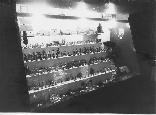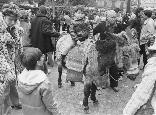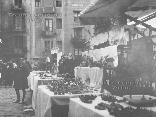
Fira de Santa Llúcia
History of the Fira de Santa Llúcia
The earliest known date for the Fira is 1786. This date is a reliable indicator of both the celebration of the Fira and of its importance, as two very trustworthy sources record it. The first of these is found in the writings of Rafael Amat, a Catalan writer of the 18th century (1746-1818), also known as Baró de Maldà. In the 60 volumes of his diary, Calaix de Sastre, he says: "13 December, Saint Lucy virgin and martyr. There were festivities in the Cathedral, in the chapel and the altar where the image of the Virgin was venerated; and outside, with the fair opposite, many stands with Nativity scenes, clay and cardboard figurines, images of saints, shepherds, animals... so there were a great many people (...) and in the Cathedral, people were attending mass and praying to the Virgin to preserve their eyesight and clarity."
The second source comes from the great folklorist and author of the Costumari Català, Joan Amades (1890-1959) who confirms 1786 as the earliest known reliable date.
Not even calamities, such as the terrible epidemic of yellow fever which struck the city of Barcelona in 1860, could halt the celebrations. Joan Amades mentions St. Lucy as the patroness of seamstresses, tailors and all needleworkers, and of the blind; this is why she is popularly known as the "defender of eyesight".
It is also said that the fair was known as the “girls' fair” as it was thought that unmarried girls went there in search of possible husbands. The girls of the area would attend, accompanied by their mothers, in their best clothes and jewellery, to find an admirer.
On St. Lucy's day, in some places in Catalonia, in the 19th century and well into the 20th, the girls who studied needlework would celebrate and run around the village or town singing songs or psalms. People called them "llucietes". In other places we know that the girls would gather to attend mass, and then go in a group around the houses collecting donations. One of them would be dressed as St. Lucy, with a crown of flowers, and the girls accompanying her were the "cardenales". In Barcelona, the seamstresses would gather in the Ciutadella park for a big party.
 In some sources we read that throughout the 19th century, in the Fira of crib scene figures, there would be people selling cardboard dolls which were animated by pulling on a string. Although they were not related to the Nativity scene, children were fascinated by them, which brought more people to the Fira.
In some sources we read that throughout the 19th century, in the Fira of crib scene figures, there would be people selling cardboard dolls which were animated by pulling on a string. Although they were not related to the Nativity scene, children were fascinated by them, which brought more people to the Fira.
Amades writes that in the 19th century the crib scene fair was held for three days: for the Blessed Virgin and for St. Lucy, in the Cathedral square; and for St. Thomas' day, in the Plaça del Pi, Plaça de Sant Josep Oriol and Plaça del Born squares. These fairs sold figures, little houses and other constructions and pieces for Nativity scenes, such as bridges, fountains, mills, wells, birdhouses, and so on. The raw materials such as moss, corl and other plants could be found on the steps of the Cathedral. Our grandparents knew very well the difference between the two fairs, one for crib scenes and one for plants.
As Nativity scenes became increasingly popular, the number of stands at both fairs grew until they merged together.
In those days it was already the custom for children to stroll around the fair with their parents, despite the winter cold, to breathe a little Christmas spirit and enjoy the skills of the sellers. When they arrived home with everything they had bought at the Fira, families would construct their Nativity scene, which would entertain the children and delight their elders.
Some pre-20th century sources note that the true pessebrist or Nativity scene maker would not create the scene before Christmas Eve, as it was considered irreverent to recreate the mystery of Christ's birth before the event.
In the earlier 20th century, on St. Lucy's day all Barcelona would flock to the small chapel dedicated to the saint to prevent eye problems. The area around the chapel would be swarming with people, and the stall-holders would sell their best pieces.
Perquè avui és Santa Llúcia
dia de l´any gloriós,
pels vols de la Plaça Nova
rondava amb la meva amor.
Anem tots dos a la fira,
amiga, anem-hi dejora,
que una mica de muntanya
alegri nostra tristor.
Comprarem grapats de molsa
i una enramada d´arboç,
i una blanca molinera,
i una ovella i un pastor.
(Fragment of Romanç de Sta. Llúcia by J. M. de Segarra).
 The installations of the Fira de Sta. Llúcia have changed considerably over time. In the early 20th century, according to the photographs which remain, the stands consisted of a large wooden board set on simple shelves, protected by a rudimentary canvas waterproofed with linseed oil, and lit by oil or acetylene lamps when it got dark.
The installations of the Fira de Sta. Llúcia have changed considerably over time. In the early 20th century, according to the photographs which remain, the stands consisted of a large wooden board set on simple shelves, protected by a rudimentary canvas waterproofed with linseed oil, and lit by oil or acetylene lamps when it got dark.
Now, in contrast, the stands are wooden, well equipped and solid, and lit by electricity.
Parallel to the stands of figures, cork objects and decorations, there were the so-called green stands, selling moss, broom, bayleaves, pine branches, cork bark and mistletoe.
The Fira de Sta. Llúcia is one of the oldest and most firmly rooted Christmas traditions of the city of Barcelona.
As well as the above we should also mention some of the many craftsmen and women from the world of Nativity scenes who made the Fira possible over its more than 200 years. The enthusiasm for crib scenes in Catalonia and the rest of Spain has produced outstanding artists in this field. Four notable figures from the past of this craft were Francisco Salzillo (1707-1783) of Murcia, Ramon Amadeu (1745-1821) of Barcelona, Damià Campeny (1771-1855) of Mataró, and Domènech Talarn (1812-1902) of Barcelona.
We know, thanks to different sources, that the Barcelonese Ramon Amadeu had a stand at Sta. Llúcia. As we can read in one of his biographies, Amadeu was born near the Church of El Pi and was of humble stock. He worked as a potter and made many crib figures, which as a young man he sold himself in the Fira. From a modest artisan he rose to be considered the best artist of his period, and it is known that when King Charles III came to Barcelona he would always visit his workshop. His works show a gentle Baroque, closer to the French style than the Italian or even Murcian.
 Unfortunately, the Napoleonic Wars, the Tragic Week and the Civil War meant that most of his work was lost or destroyed. The extant pieces can be admired in the Museum of the History of Barcelona, the Museum of Olot and in various private collections.
Unfortunately, the Napoleonic Wars, the Tragic Week and the Civil War meant that most of his work was lost or destroyed. The extant pieces can be admired in the Museum of the History of Barcelona, the Museum of Olot and in various private collections.
Later, notable modellers and workers with cork would show their wares in the Fira de Sta. Llúcia, often doubling as salesmen. These include:
Daniel José Ursueguía (Santander 1909-Barcelona 1990); Carratalà, small figures of a Catalan type; the Muns family, known for their original figures; the Castells family, with the grandchildren of Martí Castells continuing in the trade begun by their grandfather; the Bertrán family, specialising in plants and lead and clay figures; the Colomer brothers, with plastic and clay figures and artistic work in cork; Fernández Carbonell, very complex cork work; the Deulofeu family, specialists in caves and landscapes; Montserrat Ribes, who has been showing her figures in the Fira since 1997; Barceló, caves made of cork; Artesania Bonet, making cork articles with their own lighting; and many more: Abella, Anell, Joan Bel, Anna Blesa, Lluís Boix, Antoni Cendra, Francesc Costa, the Escoda brothers, Fabregat, Fernández Puigmacià, Ferrer, Gil, Gisbert, Joan Hernández, Ivars, Teresa Llort, Pasqual Macià, Gerard Marí, Anna Maristany, Marinel.lo, Aurora Mas, Miquel Moreno, Oliver, Pañellas, Puig Llobera, Riera, Semis, Silvestre, Taulé, Vidal, Vila, etc.
These days, the Fira begins in late November or early December, with more than 280 stands ordered by sectors depending on what they sell (Nativities and figures, greenery, and crafts) and located in front of the Pla de la Seu (the Cathedral square), on Avinguda de la Catedral. The sellers offer you, as they have for time out of mind, all the products you need to decorate your home for the Christmas season, and will give you a warm welcome in the hope that you will visit the Fira as often as you want as cheerfully and enthusiastically as them.
The cold is coming and Christmas too, wrap up warm and see you soon.
Bibliografia principal:
AMADES, Joan; “El Pessebre”, editat el 1946, malgrat que en el pròleg del llibre la data de publicació hi consta l'any 1935, com a llibre clandestí de l'època.
